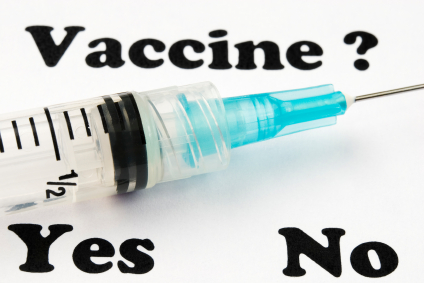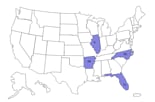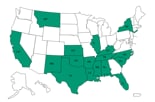Opinions Presented on Harvard Law Blogs by :
Mary Holland , Director, Graduate Legal Skills Program Research Scholar
New York University School of Law
Dorit Rubinstein Reiss, LLB, Ph.D. , Professor of Law
With a dissenting opinion with a Natural Health Point of view from :
Alliance for Natural Health USA (ANH-USA)* is part of an
international organization dedicated to promoting sustainable health and
freedom of choice in healthcare through good science and good law.
Members of Board of Directors
***************************************************************************

By Art Caplan
Measles are
breaking out
all over Britain. Getting fewer headlines is the fact that measles are
back in the USA too. In fact they are in our region. A mini-epidemic
is raging in Brooklyn. Measles for cripes sake! The disease that many
of us over 60 had as kids that should never occur is back with a
vengeance. The reason for the diseases reappearance is simple—failure
to vaccinate. Maybe it is time to get tough on those whose choices put
others at risk.
For
decades, there has been a safe, effective vaccine that works
exceedingly well against the measles–95% full protection for a kid who
has been vaccinated– and nearly equally well at preventing transmission
to others. The more people have been vaccinated the tougher it is for
measles to gain a foothold.
NY City health officials have reported 30 cases so far–26 in Borough Park and four more in Williamsburg. The NY Daily News reports that the consequences of this outbreak have been dire:
“There
have been two hospitalizations, a miscarriage and a case of pneumonia
as a result of this outbreak,” a Health Department spokeswoman said.
“All cases involved adults or children who were not vaccinated due to
refusal or delays in vaccination.”
So
far the outbreak has been among religious Jews some of whom shun
getting the vaccine for their kids out of fear it causes autism Dr. Yu
Shia Lin of Maimonides Medical Center in Borough Park told The News.
Hasidic
Jews in Brooklyn are not the only ones making poor, dangerous and
sometimes fatal choices by avoiding vaccination. 20 people were
sickened a few weeks ago in North Carolina when an unvaccinated person
came back from India, attended two youth baseball games, and later,
developed symptoms of measles having exposed many people. An infant in
Battle Creek, Michigan, whose parents traveled out of the country
without vaccinating their child against measles likely exposed others to
measles at a pediatric office and subsequently at the emergency room
where their measles-infected child was taken. And Britain is battling
an enormous outbreak of measles directly attributable to non-vaccination
Pockets
of measles spring up in places where parents choose for one reason or
another not to vaccinate and then take an infected child on a bus, to an
airport, to daycare, an amusement park, a church or other public
places.
Read More Here
***************************************************************************

Crack Down on Those Who Don’t Vaccinate?: A Response to Art Caplan
Dr. Art Caplan recently posted an editorial, “
Liability for Failure to Vaccinate,”
on this blog. He argues that those who contract infectious disease
should be able to recover damages from unvaccinated people who spread
it. If you miss work, or your baby has to go to the hospital because of
infectious disease, the unvaccinated person who allegedly caused the
harm should pay. Dr. Caplan suggests that such liability is apt because
vaccines are safe and effective. He sees no difference between this
situation and slip-and-fall or car accidents due to negligence. Arguing
that “a tiny minority continue to put the rest of us at risk,” he
suggests that public health officials can catch the perpetrators and
hold them to account through precise disease tracing.
Dr.
Caplan’s assertions to the contrary, vaccines are neither completely
safe nor completely effective. In fact, from a legal standpoint,
vaccines, like all prescription drugs, are “unavoidably unsafe.” [See,
e.g.,
Bruesewitz v. Wyeth, 562 U.S. __ (2011).] Industry considered its liability for vaccine injury so significant that it lobbied Congress for the 1986
National Childhood Vaccine Injury Act,
providing doctors and vaccine manufacturers almost blanket liability
protection for injuries caused by federally recommended vaccines. [See
Authorizing Legislation.] The liability risk was so serious that the
federal government created a special tribunal under the 1986 Act, the
Vaccine Injury Compensation Program, to pay the injured. Moreover, the
Supreme Court in 2011
decided Bruesewitz v. Wyeth,
prohibiting any individual from filing a civil suit for a defectively
designed vaccine in any court in the country. Industry’s extraordinary
protection against liability for vaccine injury does not correspond with
glib statements, like those of Dr. Caplan, that vaccines are safe and
effective. On the contrary, the law acknowledges that vaccines cause
injury and death to some, with no screening in place to mitigate harm.
Dr.
Caplan notes that public health officials have “tried to debunk false
fears about vaccine safety.” Yet the Institute of Medicine, one the
country’s most prestigious health organizations, has acknowledged
repeatedly that there are many known vaccine injuries, such as seizures
from the measles-mumps-rubella vaccine, anaphylaxis from the
meningococcal vaccine, and encephalitis from the varicella vaccine. Even
more troubling than the identified injuries is the number of potential
vaccine adverse effect relationships for which the evidence is not
sufficient to either prove or disprove causality. [Committee to Review
Adverse Effects of Vaccines, Institute of Medicine,
Adverse Effects of Vaccines: Evidence and Causality (Kathleen Straton et al. eds., 2012).]
*************************************************************************

No liability for failure to vaccinate? The case has not been made: A Response to Mary Holland
By Dorit Rubinstein Reiss, LLB, Ph.D.
Harvard Law Blogs
Dorit Rubinstein Reiss (LLB, Ph.D.) is Professor of Law at UC Hastings College of the Law. She has published articles on regulation and administrative law and teaches tort law. She is also a member of the Parents Advisory Board of Voices for Vaccines and writes the blog Before Vaccines.
In a guest post on this blog,
Mary Holland, JD, suggests that there are no grounds for imposing tort liability on parents for failure to vaccinate alone, even
if it led to another person being infected. Holland’s post is courteous
and matter-of-fact, and there are certainly arguments for that
position, especially the argument that common law rarely imposes a duty
to act. But Ms. Holland did not make that case.
A. Absence of a Common Law duty
Ms.
Holland correctly identifies that courts are reluctant to impose a duty
to act or rescue. Our legal system accords great weight to personal
autonomy and therefore hesitates to require people to act. However,
there are exceptions to this general approach, cases in which courts do
impose a duty to act, so identifying that this is a duty-to-act
situation is the start of a discussion, not the end of it. Duty is a
legal determination by the court, not an objective, observable
phenomenon independent of human will; “‘duty’ is not sacrosanct in
itself, but only an expression of the sum total of those considerations
of policy which lead the law to say that the particular plaintiff is
entitled to protection,’
Dillon v. Legg, 68
Cal. 2d 728, 730 (Sup. Ct. 1968), quoting Prosser. Various courts have
imposed a duty to act on a psychiatrist who knows of a threat a patient
poses to others (
Tarasoff v. Regents of the University of California,
17 Cal. 3d 425, 551 P.2d 334, 131 Cal. Rptr. 14 (Cal. 1976)); on a host
to protect social guests from defects on the premises (
Rowland v. Christian, 69 Cal. 2d 108 (1968)); on friends on a “joint venture” to render assistance when the friend is injured (
Farwell v. Keaton, 396 Mich. 281, 240 N.W.2d 217 (1976)). Legislatures, too, may impose a duty to act.
There
are several ways to analyze duty. Using the traditional Rowland v.
Christian, 69 Cal. 2d 108 (1968) factors, we balance, among others, “the
foreseeability of harm to the plaintiff, the degree of certainty that
the plaintiff suffered injury, the closeness of the connection between
the defendant’s conduct and the injury suffered, the moral blame
attached to the defendant’s conduct, the policy of preventing future
harm, the extent of the burden to the defendant and consequences to the
community of imposing a duty to exercise care with resulting liability
for breach, and the availability, cost, and prevalence of insurance for
the risk involved.” Out of all these factors, Holland’s analysis focused
solely on the burden to the defendant, ignoring all the other
considerations.
Holland’s arguments that the duty creates too high
a burden are that the duty violates religious freedom – addressed in
part B – and that vaccines are unsafe. To show vaccines are unsafe
Holland refers to
Bruesewitz v. Wyeth,
562 U.S. __ (2011), saying the court found vaccines “unavoidably
unsafe”; note, however, the majority in that case actually rejected the
application of that term to vaccine injuries: “… there is no reason to
believe that §300aa–22(b)(1) was invoking it. The comment creates a
special category of ‘unavoidably unsafe products,’ while the statute
refers to ‘side effects that were unavoidable.’” That the latter uses
the adjective “unavoidable” and the former the adverb “unavoidably” does
not establish that Congress had comment k (where the “unavoidably
unsafe” language originates) in mind. “Unavoidable” is hardly a rarely
used word. Nowhere does the majority say or suggest that vaccines carry a
particularly high level of risk. The Court actually speaks positively
of vaccines’ contribution to public health and sees them as “victims of
their own success.”
Holland uses the National Vaccine Injury
Compensation Program (NVICP) as evidence vaccines are unsafe; if that is
our measure of vaccine safety, vaccines are extremely safe. In the 24
years of its operation, since 1989,
the program awarded compensation for slightly less than 3300 cases. As calculated elsewhere, this is
less than 0.003% of the vaccine administered. The fatalities - not injuries – from motor vehicle accidents (35,900) and accidents around the home (65,200) were
much more numerous in 2009 alone. Children
are safer being vaccinated than driven in a car or being home. And
Holland completely ignores the benefits from vaccinating, i.e.
protection of the defendant’s own children against preventable diseases.
Like driving or being at home, vaccines are not completely risk free.
But serious harms from vaccines are rare and they provide benefits to
the person vaccinated.
Read More Here
****************************************************************************
Vaccinations
The
Alliance for Natural Health USA (ANH-USA) believes “informed choice” is
crucial in weighing health-treatment options — especially vaccinations.
As
Richard Gale and Gary Null have written: “Vaccines are suspensions of
infectious agents used to artificially induce immunity against specific
diseases. The aim of vaccination is to mimic the process of naturally
occurring infection through artificial means. Theoretically, vaccines
produce a mild to moderate episode of infection in the body with only
symptomatic, temporary, and slight side effects.”1
Theoretically.

Therefore, ANH-USA:
- advocates for the freedom of choice to be vaccinated — or not.
- believes that no one — children, pregnant women, adults, the military, seniors—should be forced to be vaccinated.
- believes that for individuals to make up their minds about vaccination, they need accurate and impartial information.
- believes that informed choice is the best way to protect the right to decide about vaccination.
The
vaccine industry owns a billion-dollar market but has meager proof of
its products’ efficacy or safety. Consumers are entitled to know exactly
what is going into their bodies — its benefits and risks — and how safe
and how effective that substance is.
Concern:
There
is mounting evidence that many vaccines are unsafe due to harmful
ingredients, such as thimerosal (mercury) and aluminum. We at ANH-USA
are worried that some inoculations may do more harm than good, and are
very concerned about the apparent lack of urgency among federal
regulators when vaccinations result in disability or death.
As
America’s infant mortality rate and the number of autistic and
chronically diseased children rise, those responsible for inoculation
schedules (the Centers for Disease Control and Prevention, the American
Academy of Pediatrics and other organizations that are funded in part by
vaccine manufacturers) fail to provide unbiased studies on the probable
link between vaccines and illness in children. And yet, federal policy
currently encourages — and in many cases requires — that all children
receive up to 36 vaccines by the age of 18 months. We believe that
parents have the right to refuse compulsory vaccinations and are
entitled to make their own informed decisions about which inoculations,
if any, they (and their children) receive.
Big Pharma drug
companies get over $10 billion per annum from the vaccine industry. It
is no surprise, therefore, that companies such as Merck and Eli Lilly
are constantly developing new vaccines, fast-tracking them through
safety checks, spending little or no time studying the long-term side
effects and failing to investigate reports of injury caused by vaccines.
Pharmaceutical companies treasure their bottom line above our health
and the health of our children.
Why do the U.S. Food & Drug
Administration, the CDC and other governmental agencies charged with
protecting consumers allow drug companies to produce and distribute
products that are tested inadequately and are sometimes even deadly?
The answer: Big PHARMA pays off researchers and top officials at the CDC.
According to Rep. Dan Burton, R-Ind.:
“They routinely allow scientists with blatant conflicts of interest to
serve on intellectual advisory committees that make recommendations on
new vaccines.”
Dr.
Sam Katz, a CDC committee chair, was a paid consultant for most of the
major vaccine makers and was also part of the team that developed the
measles vaccine. Dr. Neal Halsey, another CDC committee member, worked
as a researcher for the vaccine companies and also received honoraria
from Abbot Labs for his research on the hepatitis B vaccine.
What’s worse is that the drug companies then lobby these same agencies to make their vaccine compulsory. For example, in 2007,
lobbyists for Merck tried to get its Gardasil vaccine mandated for sixth-grade girls in
every state, despite 15,000 adverse-event reports, 3,000 injuries, 48
deaths and speculation that its long-term effects could include
infertility.
The presence of thimerosal in vaccines is also
troubling. Although it has been removed from some vaccines, this deadly
substance (which is 49.6 percent mercury by weight) still remains in
others, including the flu shot. During the 1990s, after 11 more vaccines
were added to the children’s immunization schedule, 70 million children
were inoculated with vaccines containing thimerosal. At the same time,
autism rates skyrocketed.
Read More Here
















 by
by 


